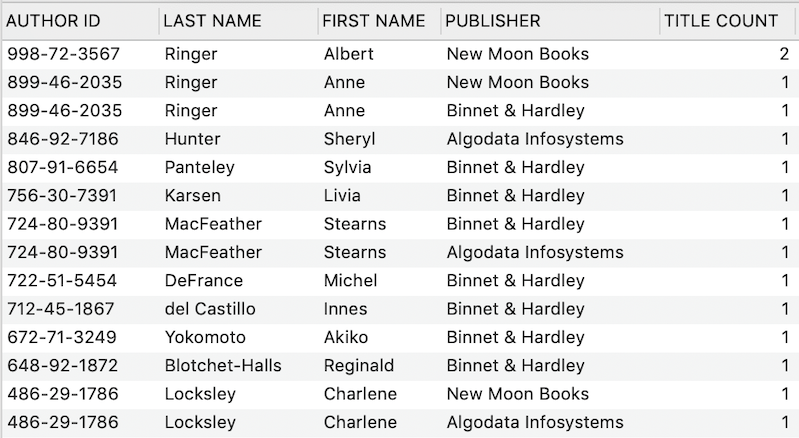In this lab you will practice how to use the MySQL SELECT statement which will be extremely useful in your future work as a data analyst/scientist/engineer. You will use the publications database that we used in the Joins and Relationships lesson. In case you haven't had that database, here is the link to download the database file.
You will create a solutions.sql file in the your-code directory to record your solutions to all challenges.
In this challenge you will write a MySQL SELECT query that joins various tables to figure out what titles each author has published at which publishers. Your output should have at least the following columns:
AUTHOR ID- the ID of the authorLAST NAME- author last nameFIRST NAME- author first nameTITLE- name of the published titlePUBLISHER- name of the publisher where the title was published
Your output will look something like below:
Note: the screenshot above is not the complete output.
If your query is correct, the total rows in your output should be the same as the total number of records in Table titleauthor.
Elevating from your solution in Challenge 1, query how many titles each author has published at each publisher. Your output should look something like below:
Note: the screenshot above is not the complete output.
To check if your output is correct, sum up the TITLE COUNT column. The sum number should be the same as the total number of records in Table titleauthor.
Hint: In order to count the number of titles published by an author, you need to use MySQL COUNT. Also check out MySQL Group By because you will count the rows of different groups of data. Refer to the references and learn by yourself. These features will be formally discussed in the Temp Tables and Subqueries lesson.
Who are the top 3 authors who have sold the highest number of titles? Write a query to find out.
Requirements:
- Your output should have the following columns:
AUTHOR ID- the ID of the authorLAST NAME- author last nameFIRST NAME- author first nameTOTAL- total number of titles sold from this author
- Your output should be ordered based on
TOTALfrom high to low. - Only output the top 3 best selling authors.
Hint: In order to calculate the total of profits of an author, you need to use the MySQL SUM function. Refer to the reference and learn how to use it.
Now modify your solution in Challenge 3 so that the output will display all 23 authors instead of the top 3. Note that the authors who have sold 0 titles should also appear in your output (ideally display 0 instead of NULL as the TOTAL). Also order your results based on TOTAL from high to low.
Authors earn money from their book sales in two ways: advance and royalties. An advance is the money that the publisher pays the author before the book comes out. The royalties the author will receive is typically a percentage of the entire book sales. The total profit an author receives by publishing a book is the sum of the advance and the royalties.
Given the information above, who are the 3 most profiting authors and how much royalties each of them have received? Write a query to find out.
Requirements:
- Your output should have the following columns:
AUTHOR ID- the ID of the authorLAST NAME- author last nameFIRST NAME- author first namePROFIT- total profit the author has received combining the advance and royalties
- Your output should be ordered from higher
PROFITvalues to lower values. - Only output the top 3 most profiting authors.
Hints:
- If a title has multiple authors, how they split the royalties can be found in the
royaltypercolumn of thetitleauthortable. - We assume the coauthors will split the advance in the same way as the royalties.
solution.sqlthat contains all your MySQL queries.
- Add
solutions.sqlto git - Commit your code
- Push to your fork
- Create a pull request to the class repo


